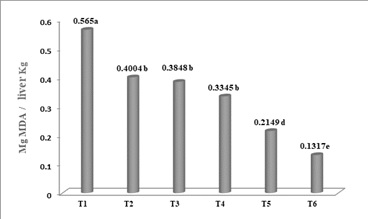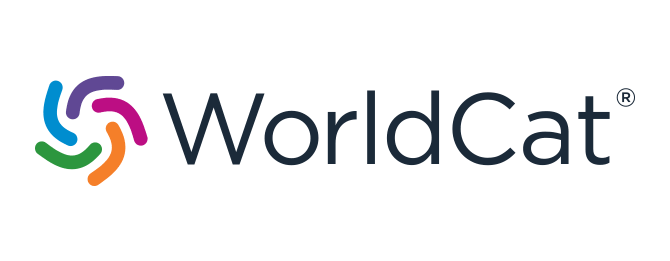IMPACT OF FEEDS CONTAINING OPTIFEED®, VÊO® PREMIUM, AND OLEOBIOTEC® ON THE LIPID PEROXIDATION OF MALE BROILERS UNDER HEAT STRESS
Views: 839 https://doi.org/10.59807/jlsar.v3i2.42
https://doi.org/10.59807/jlsar.v3i2.42
Keywords:
Feeds, Optifeed®,, Vêo®, Lipid Peroxidation, Heat Stress, BroilersAbstract
The present study was conducted to investigate the effect of adding various levels of Optifeed®, VêO® premium and Oleobiotec® to the diets as appetite stimulants in the production Performance of broiler males under heat stress conditions. The experiment was done for 42 days for the period from 30 August 2018 to 11 of October 2018 at the Poultry Research Station of the Livestock Research Department / Agricultural Research Department / Ministry of Agriculture (Baghdad - Abu Ghraib). In this study, 270 - one-day broiler males (Ross 308) were reared with a mean body weight of 37 g/chick, distributed randomly on 18 pens with dimensions of 2 x 3 m (length x width). The experimental treatments involved six treatments with three replicates for each treatment (per replicate 15 chicks). The treatments were included T1: basal diet as a control with no additions, T2: basal diet + 500 g/ton of Optifeed®, T3: basal diet + 250 g/ton of VêO® premium, T4: basal diet + 250 g/ton of Oleobiotec®, T5: basal diet + 250 g of Optifeed® + 125 g of VêO® premium + 125 g of oleobiotec® /ton of feed, T6: basal diet + 500 g Optifeed® + 250 g VêO® premium + 250 g Oleobiotec® g/ton of feed. The obtained results showed that a significant decrease in all experimental trials of Malondialdehyde (MDA) for broiler liver tissue compared to control treatment. Treatment (T6) recorded the lowest concentration of dehydrode (MDA) compared to other treatments.
Downloads
References
J. M. Koolhaas et al., “Stress revisited: A critical evaluation of the stress concept,” Neuroscience and Biobehavioral Reviews, vol. 35, no. 5. 2011, doi: 10.1016/j.neubiorev.2011.02.003.
Z. J. M. Saed, S. M. Abdulateef, T. T. Mohammed, and F. M. H. AL-Khalani, “Effect of dried tomato pomace as alternative to vitamin C supplemented diets in hematological indices and oxidative stability of egg yolk of laying hens in high-ambient temperature,” Biochem. Cell. Arch., vol. 18, no. 2, 2018.
B. H. Ali and A. A. Al-Qarawi, “An Evaluation of Drugs Used in the Control of Stressful Stimuli in Domestic Animals: A Review,” Acta Veterinaria Brno, vol. 71, no. 2. 2002, doi: 10.2754/avb200271020205.
O. Bagno et al., “Physiological status of broiler chickens with diets supplemented with milk thistle extract,” Vet. World, vol. 14, no. 5, 2021, doi: 10.14202/vetworld.2021.1319-1323.
B. H. Mousa, S. M. Abdulateef, H. A. Alhamdani, N. N. Alhayani, A. A. Alhamdani, and H. H. Nafea, “EFFECT OF DIETARY NATURAL FEED ADDITIVES TO MINIMIZE NEGATIVE ROLE OF PEROXIDE HYDROGEN IN BROILER,” Biochem. Cell. Arch, vol. 20, no. 2, pp. 5223–5230, 2020.
R. Gauthier, D. S. Hall, K. Lin, J. Baltazar, T. Hynes, and J. R. Dahn, “Impact of Functionalization and Co-Additives on Dioxazolone Electrolyte Additives,” J. Electrochem. Soc., vol. 167, no. 8, 2020, doi: 10.1149/1945-7111/ab8ed6.
O. G. N. Alani, Y. T. Abdul-Rahaman, and T. T. Mohammed, “Effect of vêo® premium and Vitamin C supplementation on lipid profile before and during pregnancy in some local iraqi ewes during heat stress,” Iraqi J. Sci., vol. 62, no. 7, 2021, doi: 10.24996/ijs.2021.62.7.1.
S. S. Rashidaie Abandansarie, P. Ariaii, and M. Charmchian Langerodi, “Effects of encapsulated rosemary extract on oxidative and microbiological stability of beef meat during refrigerated storage,” Food Sci. Nutr., vol. 7, no. 12, 2019, doi: 10.1002/fsn3.1258.
S. a S. S. A. System., SAS user´s guide. 2004.
D. B. Duncan, “Multiple Range and Multiple F Tests,” Biometrics, vol. 11, no. 1, 1955, doi: 10.2307/3001478.
M. A. Al-Harthi, “The effect of natural and synthetic antioxidants on performance, egg quality and blood constituents of laying hens grown under high ambient temperature,” Ital. J. Anim. Sci., vol. 13, no. 2, 2014, doi: 10.4081/ijas.2014.3239.
N. M. Ragaa, R. M. S. Korany, and F. F. Mohamed, “Effect of Thyme and/or Formic Acid Dietary Supplementation on Broiler Performance and Immunity,” Agric. Agric. Sci. Procedia, vol. 10, 2016, doi: 10.1016/j.aaspro.2016.09.064.
M. Pathak, G. P. Mandal, A. K. Patra, I. Samanta, S. Pradhan, and S. Haldar, “Effects of dietary supplementation of cinnamaldehyde and formic acid on growth performance, intestinal microbiota and immune response in broiler chickens,” Anim. Prod. Sci., vol. 57, no. 5, 2017, doi: 10.1071/AN15816.
M. S. Fernandez-Panchon, D. Villano, A. M. Troncoso, and M. C. Garcia-Parrilla, “Antioxidant activity of phenolic compounds: From in vitro results to in vivo evidence,” Critical Reviews in Food Science and Nutrition, vol. 48, no. 7. 2008, doi: 10.1080/10408390701761845.
M. Englmaierovà, I. Bubancovà, T. Vít, and M. Skøivan, “The effect of lycopene and vitamin E on growth performance, quality and oxidative stability of chicken leg meat,” Czech J. Anim. Sci., vol. 56, no. 12, 2011, doi: 10.17221/4416-cjas.
A. Zeb, “Concept, mechanism, and applications of phenolic antioxidants in foods,” Journal of Food Biochemistry, vol. 44, no. 9. 2020, doi: 10.1111/jfbc.13394.
P. Randjelović et al., “The beneficial biological properties of salicylic acid,” Acta Facultatis Medicae Naissensis, vol. 32, no. 4. 2015, doi: 10.1515/afmnai-2015-0026.
D. T. Babaeva, R. S. Esanov, A. A. Akhunov, M. B. Gafurov, N. R. Khashimova, and A. D. Matchanov, “Biological Activity of the Supramolecular Complex of Glycyrrhizic and Salicylic Acids,” Chem. Nat. Compd., vol. 56, no. 2, 2020, doi: 10.1007/s10600-020-03006-1.
M. Valko, H. Morris, and M. Cronin, “Metals, Toxicity and Oxidative Stress,” Curr. Med. Chem., vol. 12, no. 10, 2005, doi: 10.2174/0929867053764635.
S. C. Bondy, “Metal Toxicity, Inflammation and Oxidative Stress,” 2016.
M. I. Alzarah et al., “Inclusion of citrullus colocynthis seed extract into diets induced a hypolipidemic effect and improved layer performance,” Agric., vol. 11, no. 9, 2021, doi: 10.3390/agriculture11090808.
M. Belloni et al., “Productive, qualitative, and physiological aspects of layer hens fed with propolis,” Rev. Bras. Cienc. Avic., vol. 17, no. 4, 2015, doi: 10.1590/1516-635x1704467-472.
M. Alagawany, S. S. Elnesr, and M. R. Farag, “Use of liquorice (Glycyrrhiza glabra) in poultry nutrition: Global impacts on performance, carcass and meat quality,” World’s Poultry Science Journal, vol. 75, no. 2. 2019, doi: 10.1017/S0043933919000059.
D. Bravo, V. Pirgozliev, and S. P. Rose, “A mixture of carvacrol, cinnamaldehyde, and capsicum oleoresin improves energy utilization and growth performance of broiler chickens fed maize-based diet,” J. Anim. Sci., vol. 92, no. 4, 2014, doi: 10.2527/jas.2013-6244.
A. Porte and R. L. O. Godoy, “Chemical composition of Thymus vulgaris L. (thyme) essential oil from the Rio de Janeiro State (Brazil),” J. Serbian Chem. Soc., vol. 73, no. 3, 2008, doi: 10.2298/JSC0803307P.
A. Travel et al., “Methodologies to Assess the Bioactivity of an Herbal Extract on Immunity, Health, Welfare and Production Performance in the Chicken: The Case of Melissa officinalis L. Extract,” Front. Vet. Sci., vol. 8, 2021, doi: 10.3389/fvets.2021.759456.

Published
How to Cite
Issue
Section
Citations
License
Copyright (c) 2022 Creative Commons Attribution 4.0 International (CC-BY 4.0)

This work is licensed under a Creative Commons Attribution 4.0 International License.
This journal is licensed under a Creative Commons Attribution 4.0 International (CC-BY 4.0)















